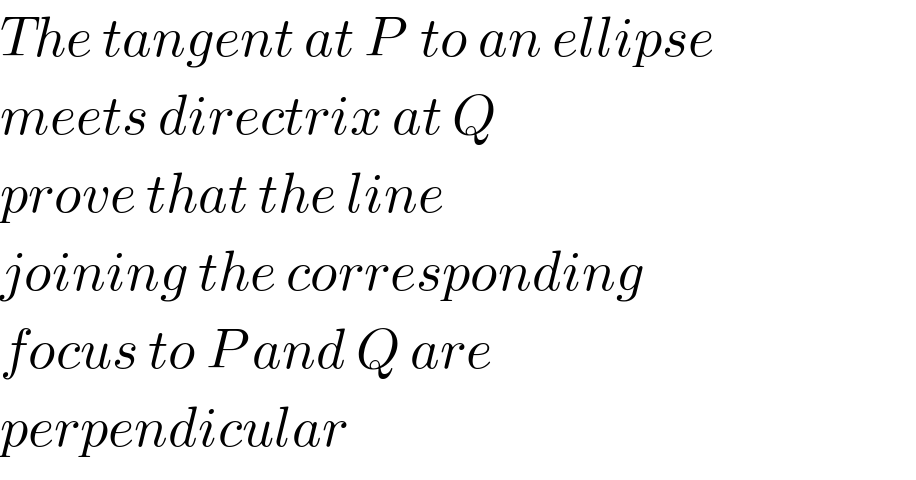
Question and Answers Forum
Question Number 51588 by peter frank last updated on 28/Dec/18

Answered by peter frank last updated on 28/Dec/18
![from tangent aysinθ+bxcos θ−ab=0...(i) P=(acos θ,bsin θ) Q=((a/e),y)⇒directrix S=(ae,0) aysinθ+bxcos θ−ab=0 put x=(a/e) aysinθ+b×(a/e)cos θ−ab=0 y=((−b(cos θ−e))/(esin θ)) Q=((a/e), ((−b(cos θ−e))/(esin θ))) S=(ae,0) slope⇒m_(SQ) =((−b(cos θ−e))/(asin θ(1−e^2 ))) P=(acos θ,bsin θ) S=(ae,0) slops⇒m_(SP) =((bsin θ)/(acos θ−ae)) SQ and SP are perpendicula slope_(SQ ) ×slope_(SP ) =−1 m_(SQ) =[((−b(cos θ−e))/(asin θ(1−e^2 ))) ]×[((bsin θ)/(acos θ−ae))] =−(b^2 /(a^2 (1−e^2 ))) [b^(2 ) =a^2 (1−e^2 ) =−(b^2 /b^2 )=−1 hence shown](Q51602.png)
| ||
Question and Answers Forum | ||
Question Number 51588 by peter frank last updated on 28/Dec/18 | ||
 | ||
Answered by peter frank last updated on 28/Dec/18 | ||
![from tangent aysinθ+bxcos θ−ab=0...(i) P=(acos θ,bsin θ) Q=((a/e),y)⇒directrix S=(ae,0) aysinθ+bxcos θ−ab=0 put x=(a/e) aysinθ+b×(a/e)cos θ−ab=0 y=((−b(cos θ−e))/(esin θ)) Q=((a/e), ((−b(cos θ−e))/(esin θ))) S=(ae,0) slope⇒m_(SQ) =((−b(cos θ−e))/(asin θ(1−e^2 ))) P=(acos θ,bsin θ) S=(ae,0) slops⇒m_(SP) =((bsin θ)/(acos θ−ae)) SQ and SP are perpendicula slope_(SQ ) ×slope_(SP ) =−1 m_(SQ) =[((−b(cos θ−e))/(asin θ(1−e^2 ))) ]×[((bsin θ)/(acos θ−ae))] =−(b^2 /(a^2 (1−e^2 ))) [b^(2 ) =a^2 (1−e^2 ) =−(b^2 /b^2 )=−1 hence shown](Q51602.png) | ||
| ||